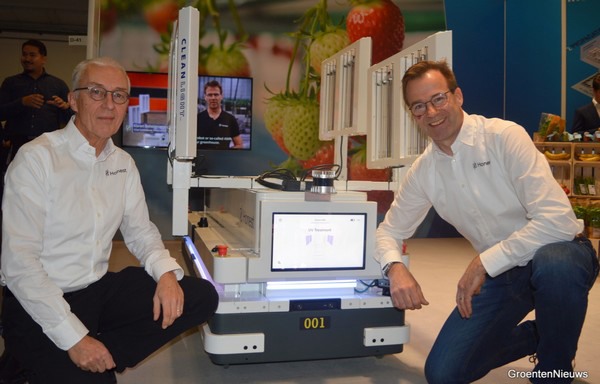Honest Agtech, together with CleanLight, presented a unique robot at Fruit Logistica. Unique because the robot has a higher level of autonomy than a Tesla, states Maren Schoormans. Autonomous Mobile Robots (AMRs) are the successors of AGVs, he says. "Our robot is able to navigate inside greenhouses without depending on external hardware such as chains, wires, tags, or beacons."
Autonomous navigation inside greenhouses is a difficult task due to the unstructured environment. There are a number of reasons for this, such as that the glass roof interferes with GPS signals. Without access to accurate location information, autonomous robots must rely on sensor-based navigation and mapping systems instead.
Using autonomous robots in greenhouses by daylight is an extra challenge, as the incidence of light varies continuously. These systems of Honest apply sensor fusion, which is the ability to bring together input from multiple radars, Lidars, and cameras to form a single model to understand the environment around the vehicle. "3D lidar sensors are actually 'extremely sensitive rangefinders' that scan the environment without light interfering with the image." All data from sensors and cameras come together in a model. "That model is more accurate because it balances the strengths of the different sensors."

Jasper den Besten and Maren Schoormans next to the robot of Honest Agtech at Fruit Logistica 2023
With these capabilities in place, autonomous robots can navigate safely within the confines of a greenhouse even without relying on GPS signals from satellites. "This makes it easy to introduce additional machines and robots in existing greenhouses without making any changes to them." In the unlikely event that the robot encounters an obstacle, the robot is equipped with a system that immediately notifies the grower. At a signal, the grower can come and have a look, remove the obstacle, and give the robot more space to continue working.
With the first robot deployed and trained, adding more robots to increase efficiency is just one step away, the robot builders believe. "Each bot will inherit all of its predecessor's training and intelligence, so they can communicate with each other as well as external systems for a fully optimized greenhouse."
Through the use of advanced technologies, such as multiple types of sensors (2D- and 3D lidars and ultrasound sensors) and AI models, it is possible to accurately measure distances and perceive the environment with computer vision. "This precise data allows a robot to map its environment, which is essential for efficient navigation. Simultaneous Localisation and Mapping (SLAM) effectively resolves the problem by executing mapping and localization simultaneously."
This is a major step forward in improving the automation of greenhouses, according to Maren, paving the way to more precise and sustainable operations. "Thanks to this technology, one AMR is capable of safely and autonomously applying sustainable crop protection based on UV-C to as much as 10 hectares of strawberries or 6 hectares of cucumbers." Honest showed their robot UC-C-solution at the recent Fruit Logistica. And how about Tesla? "They have autonomy level 3, and we have 5. But it's fair to say Tesla operates in a much more complex environment: public roads."
For more information about these autonomy levels and the robot, Honest offers a white paper.
Voor meer informatie:
Maren Schoormans
Honest AgTech
maren.schoormans@honest.ag
www.honest.ag
